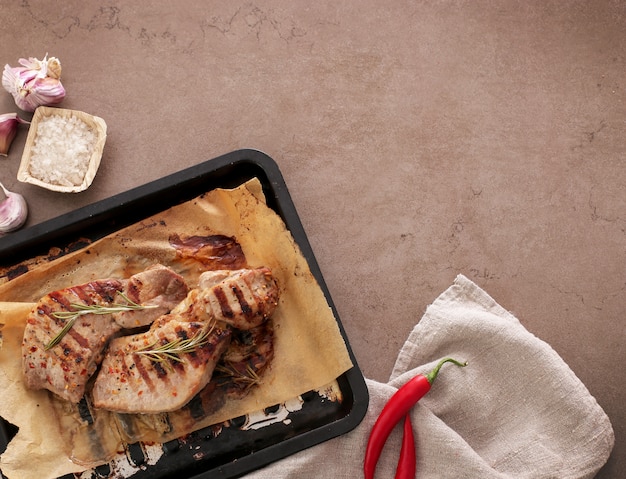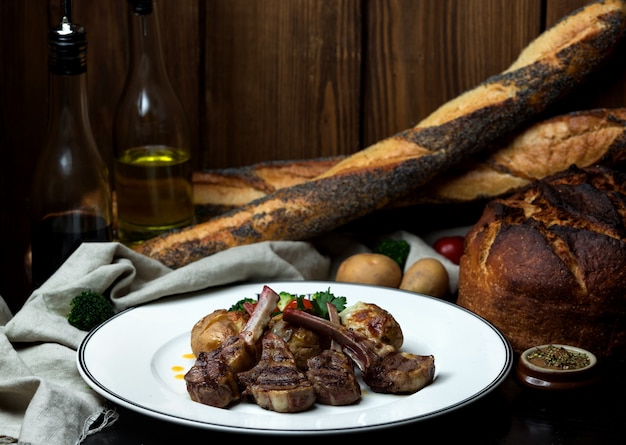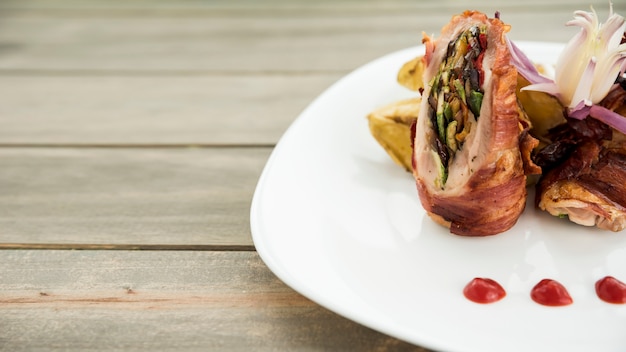(Part 1) Picking the Perfect Rack

Choosing the Right Cut
First, you'll want to choose a rack with at least 7 or 8 ribs, and ideally, it'll have a nice layer of fat on top. Don't be afraid of the fat! It's your friend; it'll render down during cooking, adding flavour and keeping the meat incredibly moist. Now, there are two main types of cuts – French and English. The French cut, my personal favourite, is cut between the ribs, making it easier to remove the bones later. It's also often served as a single rack, which looks incredibly impressive on a plate, if I do say so myself. The english cut, on the other hand, is cut along the ribs, leaving a long, connected bone structure. It's often served in two racks, but it can be a bit trickier to work with when carving.
Judging the Meat
When you're looking at the rack, give it a good sniff. It should have a clean, slightly sweet aroma. Avoid anything that smells off or ammonia-like; that's a sign the meat isn't fresh. Another thing to look for is the colour of the fat. It should be a nice, creamy white colour, not yellowed or discoloured. A good rule of thumb is to pick a rack that has a good marble pattern, meaning the fat is well-distributed throughout the meat. It's a good indicator of a tender and juicy cut. And remember, don't be afraid to ask your butcher for advice. They're the experts, and they can help you choose the perfect rack for your needs.
(Part 2) Prepping the Lamb

The Pat Down
First things first, pat the lamb dry with kitchen paper. It might seem like a small step, but it really helps with getting a nice, crispy skin. I've learned this the hard way; a damp surface won't crisp up as well. Trust me on this one!
The Seasoning
Next, it's time to season. I'm a big fan of a simple salt and pepper rub, but feel free to get creative. You can add herbs like rosemary, thyme, or oregano, or even a pinch of paprika or garlic powder. Don't go overboard, though – you want to enhance the lamb's natural flavour, not mask it. For a more robust flavour, you could also try a rub with a bit of mustard powder or cumin.
The Resting
Now, here's a crucial step that many people skip: Let the lamb rest at room temperature for about 30 minutes before cooking. This helps the meat to cook more evenly and results in a more tender and juicy final product. While it's resting, preheat your oven or get your grill ready.
(Part 3) Cooking the Lamb

Roasting
My preferred method is roasting in the oven. I usually cook it at a high heat, around 220 degrees Celsius (425 degrees Fahrenheit), for about 15-20 minutes, to get a nice crust on the outside. Then, I reduce the heat to 180 degrees Celsius (350 degrees fahrenheit) and cook it for another 15-20 minutes, depending on the thickness of the rack and how well done you like it. Don't forget to use a meat thermometer to check the internal temperature. I aim for around 55 degrees Celsius (130 degrees Fahrenheit) for medium-rare, but you can adjust that based on your preference.
Grilling
If you're feeling adventurous, you can also grill the lamb. I find this works well with smaller racks, but you need to watch it closely to avoid burning. Preheat your grill to medium-high heat and cook the rack for about 5-7 minutes per side, turning it once. Again, use a meat thermometer to check the internal temperature. A good tip for grilling is to keep the lid closed for most of the cooking time, which helps to create a more even heat.
Using a Pan
For a more intense flavour, you can try searing the rack of lamb in a pan before roasting. Heat a heavy-bottomed pan over high heat, and sear the lamb for about 2-3 minutes per side, until it's nicely browned. Then, transfer it to your roasting pan and continue cooking as described above.
(Part 4) Resting Again
After the lamb is cooked, let it rest for 10-15 minutes before carving. This allows the juices to redistribute, resulting in a more tender and flavourful roast. It's a good idea to cover it loosely with foil while it rests.
(Part 5) Carving the Lamb
Now, this is a bit of a performance! A rack of lamb is a beautiful piece of meat, so don't be afraid to show it off. Grab a sharp knife, and start by cutting between the ribs. If you've chosen a French cut, the bones will come out easily. If you've got an English cut, you might need to use a bit more force.
Once the bones are removed, you can carve the lamb into individual chops. I prefer to keep the chops together and serve them whole, but you can also slice them into thinner pieces.
(Part 6) Serving the Lamb
Right, it's showtime! Your lamb is cooked to perfection, looking beautiful and smelling divine. Now, what to serve it with?
The Sides
You can't go wrong with classic roast vegetables, like carrots, potatoes, and Brussels sprouts. A nice green salad with a vinaigrette dressing is another great option. For something a bit fancier, try roasted asparagus or a gratin dauphinois. If you want to keep it simple, a bed of creamy mashed potatoes is always a winner. And don't forget about a good selection of sauces!
The Sauce
A good sauce is essential for a rack of lamb. My favourite is a simple mint sauce, made with chopped fresh mint, a bit of sugar, and white wine vinegar. For a richer flavour, try a red wine sauce, made with red wine, beef stock, and herbs. Or, for a more robust taste, try a mustard sauce, made with Dijon mustard, honey, and a splash of white wine. You could even try a creamy gravy made with pan juices and a touch of cream.
The Garnishes
Don't forget to add some finishing touches! A sprig of rosemary or a few thyme leaves scattered over the lamb can add a touch of elegance. You could also drizzle the lamb with a little olive oil or melted butter for extra richness.
(Part 7) Leftover Lamb
Okay, so you've made a delicious rack of lamb, and you've got some leftovers. Don't worry, they're a good thing! Leftover lamb is incredibly versatile and can be used in a variety of dishes.
The Options
You can make a delicious lamb salad with leftover lamb, chopped into bite-sized pieces and tossed with lettuce, tomatoes, red onion, and a vinaigrette dressing. Or you could try a lamb sandwich, using leftover lamb on crusty bread with your favourite toppings. Don't forget about lamb curry, which is a tasty and satisfying dish. You can also use leftover lamb in a shepherd's pie or a hearty stew.
(Part 8) The Verdict
That's it, folks! The ultimate guide to cooking a perfect rack of lamb. It's a classic for a reason, so don't be afraid to give it a go. Remember to choose a good quality rack of lamb, season it well, and cook it to perfection. And most importantly, enjoy the process!
FAQs
Now, I know you might have a few questions. So, here are some FAQs about cooking rack of lamb.
Q1: How do I know when my lamb is cooked?
The best way to tell if your lamb is cooked is to use a meat thermometer. For medium-rare, aim for an internal temperature of 55 degrees Celsius (130 degrees Fahrenheit). For medium, aim for 60 degrees Celsius (140 degrees Fahrenheit). And for well-done, aim for 71 degrees Celsius (160 degrees Fahrenheit).
Q2: What happens if I overcook my lamb?
If you overcook lamb, it'll become tough and dry. It's best to err on the side of undercooked, as it can always be cooked a little more. If you're worried about overcooking, take the lamb out of the oven a few degrees before reaching your desired temperature, and let it rest. The internal temperature will continue to rise slightly as it rests, ensuring it reaches the perfect level of doneness.
Q3: Can I cook a rack of lamb on the stovetop?
Yes, you can cook a rack of lamb on the stovetop, but it's best to use a heavy-bottomed skillet and cook it over medium-high heat. You'll also want to sear it on all sides to get a nice crust. This method is great for smaller racks or if you want a quicker cooking time.
Q4: Can I freeze a rack of lamb?
Yes, you can freeze a rack of lamb, but it's best to wrap it tightly in plastic wrap and aluminum foil before placing it in the freezer. It should last for 3-4 months in the freezer. When you're ready to use it, defrost it in the refrigerator overnight.
Q5: What's the best way to reheat leftover lamb?
The best way to reheat leftover lamb is in the oven. Preheat your oven to 180 degrees Celsius (350 degrees Fahrenheit), place the lamb in a baking dish, and bake it for 10-15 minutes, or until heated through. You can also reheat it in a skillet on the stovetop over low heat, but be careful not to overcook it.
Q6: What are some other tips for cooking a rack of lamb?
Here are a few extra tips that might help:
- Use a meat thermometer to ensure your lamb is cooked to your liking.
- Let the lamb rest after cooking to allow the juices to redistribute.
- Don't be afraid to experiment with different seasonings and herbs.
- Serve the lamb with a variety of side dishes and sauces to create a balanced and delicious meal.
(Part 9) Beyond the Basics: Exploring Flavours
Now that you've got the basics down, let's talk about some more advanced techniques and flavours to take your rack of lamb to the next level.
Marinade Magic
A marinade can add a whole new dimension of flavour to your lamb. My favourite marinade is a simple blend of olive oil, lemon juice, garlic, and herbs. You can also add other ingredients like Dijon mustard, honey, or soy sauce. The key is to let the lamb marinade for at least a few hours, or even overnight, to allow the flavours to penetrate the meat.
Herb-Crusted Lamb
For a visually stunning and flavourful dish, try coating the lamb with a herb crust. Simply combine chopped herbs like rosemary, thyme, parsley, and garlic with breadcrumbs, grated parmesan cheese, and olive oil. Press this mixture onto the lamb, ensuring it's evenly coated. This crust will create a beautiful golden brown finish and add a burst of flavour to each bite.
The Power of Pancetta
For a decadent and flavourful twist, wrap the rack of lamb in pancetta. The pancetta will render down as it cooks, adding a salty and smoky flavour to the lamb. Before wrapping, you can also rub the lamb with a spice rub or marinade for extra flavour.
(Part 10) The Final Word on Lamb
Cooking a perfect rack of lamb is a rewarding experience that will impress your guests and leave everyone wanting more. It's a dish that allows you to showcase your culinary skills and enjoy the delicious flavours of this classic cut of meat. So, go on, grab your favourite seasonings, and get ready to create a masterpiece!
Everyone is watching

Prime Rib Roast Cooking Time Chart: Per Pound Guide
Cooking TipsPrime rib roast. Just the name conjures images of lavish dinners, crackling fires, and hearty laughter. It’s ...

How Long to Bake Potatoes in the Oven (Perfect Every Time)
Cooking TipsBaked potatoes are a staple in my kitchen. They're incredibly versatile, delicious, and surprisingly easy to m...

Perfect Rice Every Time: The Ultimate Guide to Cooking Rice
Cooking TipsAs a self-proclaimed foodie, I've always been a bit obsessed with rice. It's the foundation of countless cuisi...

The Ultimate Guide to Cooking Asparagus: Tips, Techniques, and Recipes
Cooking TipsAsparagus. The mere mention of this spring delicacy conjures up images of vibrant green spears, crisp and burs...

Ultimate Guide to Cooking the Perfect Thanksgiving Turkey
Cooking TipsThanksgiving. Just the word conjures up images of overflowing tables laden with delicious food, the scent of r...
